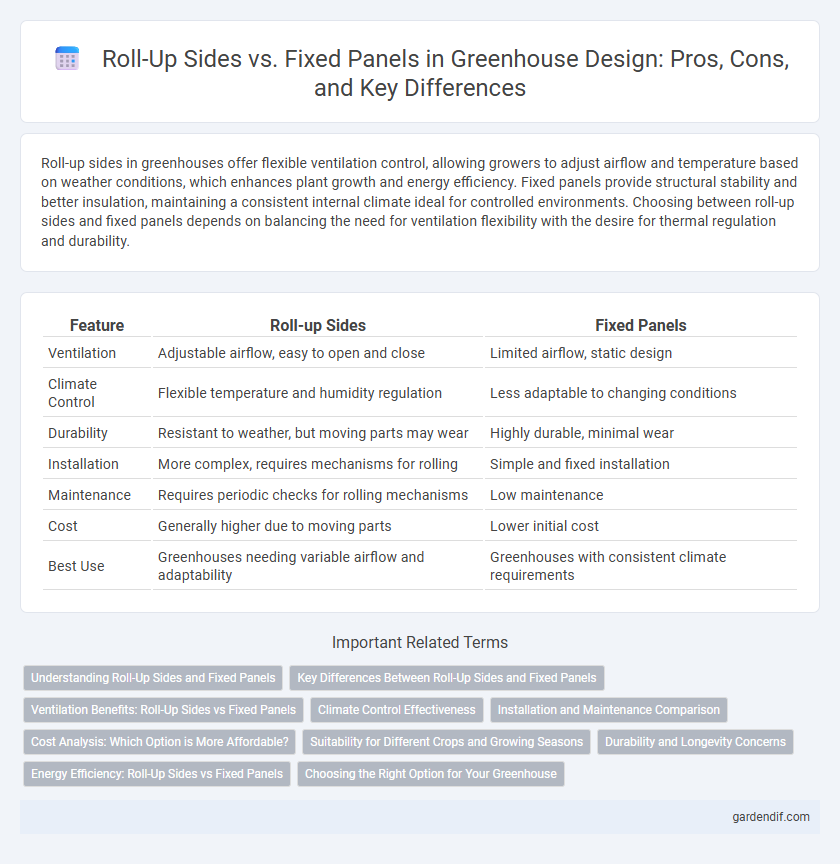
Roll-up sides vs fixed panels Illustration
Roll-up sides in greenhouses offer flexible ventilation control, allowing growers to adjust airflow and temperature based on weather conditions, which enhances plant growth and energy efficiency. Fixed panels provide structural stability and better insulation, maintaining a consistent internal climate ideal for controlled environments. Choosing between roll-up sides and fixed panels depends on balancing the need for ventilation flexibility with the desire for thermal regulation and durability.
Table of Comparison
| Feature | Roll-up Sides | Fixed Panels |
|---|---|---|
| Ventilation | Adjustable airflow, easy to open and close | Limited airflow, static design |
| Climate Control | Flexible temperature and humidity regulation | Less adaptable to changing conditions |
| Durability | Resistant to weather, but moving parts may wear | Highly durable, minimal wear |
| Installation | More complex, requires mechanisms for rolling | Simple and fixed installation |
| Maintenance | Requires periodic checks for rolling mechanisms | Low maintenance |
| Cost | Generally higher due to moving parts | Lower initial cost |
| Best Use | Greenhouses needing variable airflow and adaptability | Greenhouses with consistent climate requirements |
Understanding Roll-Up Sides and Fixed Panels
Roll-up sides in greenhouses offer adjustable ventilation by allowing sections of the sidewalls to be rolled up or down, improving airflow and temperature regulation. Fixed panels provide sturdy, non-movable sections that enhance structural integrity and insulation but limit flexibility in controlling internal climate. Choosing between roll-up sides and fixed panels depends on the desired balance between ventilation efficiency and thermal stability in greenhouse management.
Key Differences Between Roll-Up Sides and Fixed Panels
Roll-up sides in greenhouses provide adjustable ventilation, allowing for customizable airflow and temperature control, unlike fixed panels which remain stationary and offer limited ventilation options. Fixed panels contribute to structural stability and insulation but lack the flexibility of roll-up sides in adapting to changing weather conditions. Choosing between roll-up sides and fixed panels depends on the need for dynamic climate control versus enhanced durability and insulation.
Ventilation Benefits: Roll-Up Sides vs Fixed Panels
Roll-up sides in greenhouses offer superior ventilation control, allowing for adjustable airflow based on temperature and humidity levels, which reduces the risk of overheating and improves plant health. Fixed panels provide limited ventilation, often requiring additional mechanical systems to maintain optimal growing conditions. The flexibility of roll-up sides enhances natural air circulation, leading to more consistent temperature regulation and energy efficiency compared to fixed panel designs.
Climate Control Effectiveness
Roll-up sides in greenhouses enhance climate control effectiveness by allowing precise ventilation adjustments, which regulate temperature and humidity levels more efficiently than fixed panels. Fixed panels often limit airflow management, potentially causing temperature fluctuations and less optimal growing conditions. The dynamic nature of roll-up sides promotes better air circulation, reducing heat stress and improving overall plant health inside the greenhouse environment.
Installation and Maintenance Comparison
Roll-up sides in greenhouses offer easy installation with adjustable ventilation controls that require minimal tools, while fixed panels demand a more permanent setup involving screws or bolts and often professional assistance. Maintenance for roll-up sides includes regular inspection of the rolling mechanism and weather seals to ensure smooth operation, whereas fixed panels typically require less frequent upkeep but may need resealing or panel replacement over time. The versatility of roll-up sides enhances airflow management, reducing the risk of mold and plant diseases, compared to fixed panels which provide more structural stability but less flexibility in environmental control.
Cost Analysis: Which Option is More Affordable?
Roll-up sides generally offer a more affordable option for greenhouses compared to fixed panels due to lower installation and material costs, as they use lightweight, flexible materials like vinyl or polyethylene. Fixed panels, often made of glass or rigid polycarbonate, incur higher expenses from durable materials and labor-intensive installation. When evaluating long-term costs, roll-up sides also provide energy savings by enabling ventilation control, potentially reducing cooling expenses in warmer climates.
Suitability for Different Crops and Growing Seasons
Roll-up sides in greenhouses offer adjustable ventilation, making them ideal for crops requiring temperature control and airflow during warm growing seasons, such as tomatoes and peppers. Fixed panels provide stable insulation and are better suited for cold-season crops like leafy greens that benefit from consistent temperatures. Selecting between roll-up sides and fixed panels depends on the specific temperature and humidity needs of the plants cultivated throughout various growing cycles.
Durability and Longevity Concerns
Roll-up sides in greenhouses offer flexible ventilation but may face durability challenges due to frequent handling and exposure to weather, leading to potential wear and tear. Fixed panels provide enhanced structural stability and extended lifespan by minimizing movement and stress on materials, making them ideal for long-term use. Selecting materials like UV-resistant polycarbonate or tempered glass further improves the longevity of either option by protecting against environmental degradation.
Energy Efficiency: Roll-Up Sides vs Fixed Panels
Roll-up sides in greenhouses enhance energy efficiency by improving ventilation and temperature control, reducing the need for artificial cooling during warm months. Fixed panels, while providing better insulation in cold climates, may trap heat and limit airflow, potentially increasing reliance on heating or cooling systems. Selecting between roll-up sides and fixed panels depends on the climate and energy goals, with roll-up sides favoring dynamic airflow management and fixed panels offering consistent thermal insulation.
Choosing the Right Option for Your Greenhouse
Roll-up sides provide adjustable ventilation for greenhouses, allowing precise control of temperature and airflow, which is crucial for plant health and growth. Fixed panels offer maximum structural stability and insulation, suitable for climates with extreme weather or where consistent internal conditions are needed. Selecting between roll-up sides and fixed panels depends on balancing ventilation needs, climate conditions, and desired durability of the greenhouse structure.
Roll-up sides vs fixed panels Infographic

 gardendif.com
gardendif.com